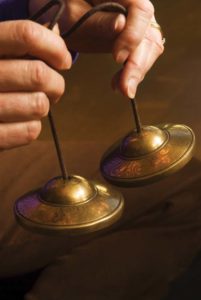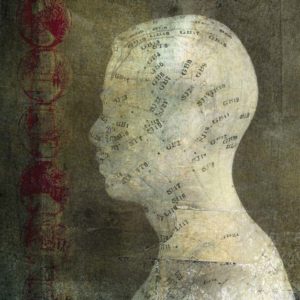
The modern age has its contradictions, and medicine is often at the center of our tensions. Cutting-edge scientific advances may prolong our lives and lessen our pains, but non-traditional and sometimes unproven alternatives are attracting greater numbers each year. Roughly 40 percent of respondents to a broad 2009 Study by the National Center for Complementary and Alternative Medicine reported using some form of alternative medicine. The efficacy of these methods range from the proven (massage for headaches, fish oil for lowering cholesterol), to the dubious (supernatural powers and telephone energy clearing). But the majority exist in a scientific gray area—unproven, but not harmful.
Complementary and alternative medicines ask a simple question: When proven Western science can be joined by drug-free and non-invasive methods to offer a further release from the grip of pain and disease, why not consider the alternative?
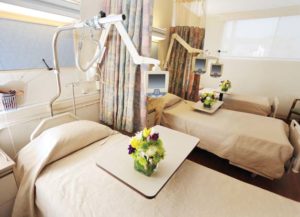
Hospitals as Healing Spas
Massage and acupuncture right in your hospital room? At hospitals across the country, ancient Eastern healing practices are merging with Western clinical medicine to develop a more holistic approach to healthcare.
“Hospitals are starting to understand that the complementary processes of both traditional and non-traditional medical care benefits the patient significantly,” said Erin Pfaeffle, director of St. Luke’s Center for Community Health and the developer of the hospital’s Integrative Therapies program. “We have an unbelievable pool of complementary health practitioners in the Valley—a community that’s already open to caring for themselves using multiple healing modalities. It was a really natural fit for this community.”
The first integrative therapies available for St. Luke’s patients were acupuncture, massage, healing touch and guided imagery. “There has been a lot of research on all the modalities we chose,” Pfaeffle said. “It was really important that what we chose had scientific research behind it.”
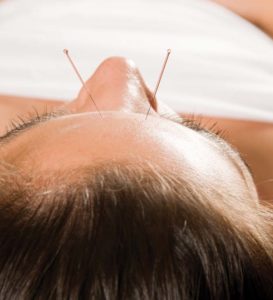
Acupuncture
Legend has it that the ancient practice of acupuncture was developed when early Chinese physicians observed the unpredicted effects of puncture wounds in warriors. The practice evolved into a science of inserting tiny needles along the body’s meridian points to open the chi, or energy flow, to relieve pain.
“One use of acupuncture in the hospital is during post-surgery to reduce swelling, pain or nausea,” said Mary Kay Foley, coordinator for the Integrative Therapies program at St. Luke’s, where all on-site acupuncturists pass a strict certification process administered by the hospital. “Pain reduction helps the healing process,” Foley said. “Studies have shown that the use of acupuncture can reduce a patient’s need for pain-reducing medication.”
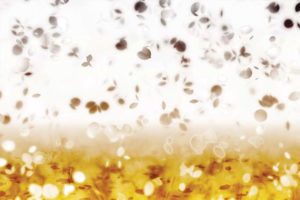
Guided Imagery
A hospital is an intimidating place, so some progressive administrators are bringing guided imagery and music into every room to help patients focus on healing instead of tubes, charts and bills.
Research shows that viewing natural scenes of flowing rivers or falling leaves along with relaxing music can promote relaxation and relieve stress. Guided meditation can provide bedridden patients a more interactive relaxation.
“The use of beautiful images and visualizations to reduce stress helps people breathe more slowly, relax and think positive thoughts,” Foley said. The resulting decrease in blood pressure and heart rate can aid the healing process.
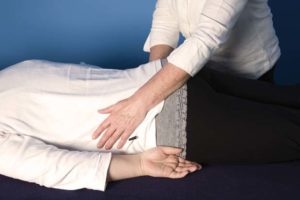
Massage
The benefits of massage include pain relief, reduced anxiety, and temporarily reduced blood pressure and pulse.
but assuredly in rubbing.”
– Hippocrates
“It’s all about patient-centered care—helping the patient be as relaxed and comfortable as they can be in a stressful situation,” Pfaeffle explained. “We change the environment. We can help make a patient’s experience more relaxing by using techniques that have been scientifically shown to facilitate healing.” No longer a cold, clinical institution—integrative medicine is all about hospital as nurturer.
Healing Touch
From Native American shamans to Japanese reiki, the “laying on of hands” has been practiced through the ages. Today, it’s becoming more accepted as a formalized alternative therapy, complete with training centers and certification processes.
In healing touch practice, a patient lies clothed while the healer gently places his hands on (or slightly above) the individual. Sessions generally last 40 to 60 minutes, and patients frequently report feeling deeply relaxed and peaceful during and after the session. It also helps in reducing stress, calming anxiety and decreasing pain.
“Healing touch has a strong history with holistic nursing,” Foley said. “Healers went into the line of work wanting to help comfort, relax and be connected to people. A lot of it is an intuitive, natural interaction—a caring person giving you energy in a positive way.”
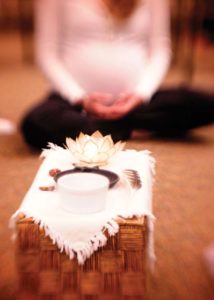
Change Your Brain, Change Your Life
Can you restructure your brain cells through meditation?
Recent studies say yes. Various types of meditation may change your brain and even affect your genes—reprogramming a calmer response to the stresses of life. According to meditation instructor and author Dean Sluyter, the practice may even “drastically slow the aging process.”
Why is this ancient practice the latest remedy to de-stress modern American life? To Sluyter, author of The Zen Commandments and a meditation teacher in New Jersey, meditation is a way to live your life more fully every moment. Practice can remedy depression and insomnia while even increasing sense of humor and mental flexibility. (Ever notice how often the Dalai Lama is laughing?)
“When people practice meditation, they settle into a state that can be called ‘restful alertness,’ where the mind is wide awake, experiencing, yet not caught up in the boundaries of any particular experience,” Sluyter explained. “There’s about 40 years of research now to corroborate the physiological reality of that state, as well as its long-term results. Stress tends to dissolve, and all sorts of results of stress dissolve along with it, from asthma to hypertension.”
In the Wood River Valley, Valerie Skonie agrees. “Meditation is a practice that leads to healing, rejuvenation and inner peace,” she said. Skonie is the founder of A Winter Feast for the Soul, an event that encourages meditation through a web-based collective. Rumi, the 13th century Persian poet, inspired Skonie to create her winter meditation event with this poem:
What nine months does for the embryo,
forty early mornings will do
for your growing awareness.
Not that you really have to get up early, but regimentation does help. Winter Feast participants sign up at www.winterfeastforthesoul.com and commit to 20 to 40 minutes of meditation (either solitary or in a group) each day for 40 days. Participants have written to Skonie about transformations in their lives. One woman’s teenage son told her, “Mom, whatever you’re doing, keep doing it. It’s affecting the whole family.”
Skonie thinks that what distances us from our own health and happiness is “an undisciplined mind, the fear of failure and the inner critic—all separating us from our own inner guidance. Meditation is a disciplining, retraining of the mind. For 40 minutes a day, you’re letting go of all judgments. Meditation is about starting over. As soon as you stop judging yourself, you will ultimately stop judging the people around you, and you and they will be at peace.”
Skonie’s program has spread to teens at Wood River High school, a local first-grade class and even prisons. The website links to instructional sites and a variety of guided meditations recorded by prominent teachers from a variety of backgrounds, including Sufi, Buddhist and non-denominational.
Skonie’s ultimate goal is a big one—“to support people around the world in a daily practice which creates inner peace and which translates into world peace.”
For Further Reading on Meditation click here
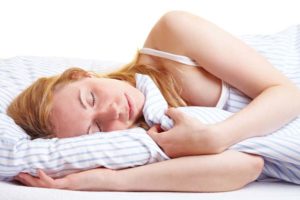
Sleep, Please!
Sleep is the elusive goal of our hectic modern lives. Everyone wants it, and no one can get enough. With new research revealing sleep’s prime importance to a healthy life and a strong immune system, the pressure is on to get some rest.
Sleep takes up one-third of our life, and it’s not just the advised eight hours that’s important. Sleep scientists have discovered that quality is as important as quantity.
At the Sun Valley Sleep Center, Doctor Kim Vorse said that we must all cycle through every sleep stage uninterrupted. Cycles that are fragmented in any way (by snoring, blocked nasal passages or pain) can substantially affect our health, beyond the obvious fatigue and irritability. Incomplete sleep can result in reduced immune function, depression, high blood pressure, diabetes and obesity.
WHAT CAN WE DO?
The Sun Valley Sleep Center’s Sleep Hygiene Tips:
Follow a regimen
- Keep a consistent bed and wake schedule, even on weekends.
Plan a bedtime routine—whether it’s a cup of herbal tea (chamomile, catnip, anise or fennel are good) or reading, find habits to slow down and ease into sleep. White noise machines help lull some. (Check www.simplynoise.com for a great online noise source.)
- Create a proper sleep atmosphere
Keep a dark, quiet, cool, clean and comfortable room (and a sleep mask if necessary).
- Avoid stimulants such as TV, computer or work materials.
No pets or plants—dander and mold can interrupt breathing.
- No hot baths right before bed—body temperature needs to be cool to sleep.
- Avoid emotional stress
Bedtime is not the time to discuss emotional issues. Don’t avoid problems, but set a time earlier in the day for heavy discussions.
- The Mattress Matters
Have a medium-firm mattress replaced every seven years or so.
- Replace humidifiers with a HEPA filter
Humidifiers can cause mold, but a HEPA (High Efficiency Particulate Air) filter cleans the air of dust, dead cells, pet dander and other allergens.
Good Vibrations
Vibrational therapy uses vibrations elicited from sound, aroma, crystals and even flower essences to balance the body. The concepts are distinctly New Age, but they have historical roots. Vibrational therapy is where modern physics’ string theory and ancient shamanic rituals meet. The common idea is that our world is made up of energy, and when we can transfer specific energies from one vital life form to another, blockages can clear, pain can lessen and our systems can regain balance.
A Healing Note
Any audiophile can attest to the powerful effects of music. It can move us from the depths of sorrow to the heights of joy, and today, scientists are studying how music affects the brain.
Alternative sound therapy aims to re-pattern unbalanced physiological systems. At Canyon Ranch spas, therapists use tuning fork therapy. Spa spokesperson Heather Wendling said their therapists apply the vibrating forks to “acupuncture points, chakras and trigger points to awaken and align the meridians and energy centers of the body.”
-Brian Greene, physicist
During healing sound workshops held by the Spanish Association of Sound Therapy, people lie comfortably on mats while sound therapists play a variety of instruments, including Tibetan singing bowls, flute, Native American frame drum, Australian didgeridoo, ocean drum, rainsticks, tuning forks, the kalimba and more.
Local acupuncturist and massage therapist Veronica Rheinhart uses the sound of quartz crystal singing bowls for their soothing sounds. A suede-covered mallet rides the rim of a bowl, creating clear vibrating tones, and the body “picks up vibration like food,” Rheinhart said.
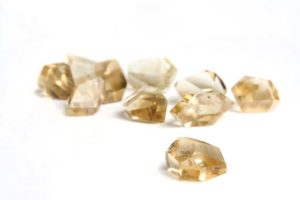
Not Your Average Stone
Crystals and gemstones are among the most valued natural elements on Earth. There’s a reason diamonds are the symbol of our most sacred ceremony; historically, rare crystals have been valued for more than their beauty alone.
While its fringe following is easily caricatured, crystal healing has historical roots. Gemstones such as jade, turquoise and lapis lazuli were used for amulets, ceremonies and daily adornment by ancient cultures including the Chinese, Hopi Indians and South Pacific islanders. The Chinese emperor Qianlong allegedly wrote more than 800 poems about jade, he loved it so.
In modern day crystal healing, gems are said to generate a healing vibration. The crystals can be worn as jewelry, carried in the pocket, placed on a specific part of the body or used in meditation. Judy Hall’s Crystal Bible is a comprehensive source book. Here are a few common gems and their properties, according to Hall:
A selection of gems used in healing:
Jade Prized especially in the Far East, the stone is a symbol of purity and serenity. It is said to release negative thoughts and soothe the mind. Jade mining came under much scrutiny following the 2002 release of Stone of Heaven, by Adrian Levy and Cathy Scott-Clark, two enterprising British journalists who covered the history of the stone, right up to its brutal mining practices in Burma (today’s Myanmar).
Citrine This crystal (pictured above) is said to carry the energy of the sun. Citrine ranges in color from yellow to a smoky brown, but buyer beware, as heat-treated amethyst is sometimes sold as citrine, and the natural variety is relatively rare. The stone is said to cleanse the chakras and, unlike some crystals, never needs cleansing itself.
Amethyst One of the most common crystals in the world, this purple-violet quartz was traditionally worn to prevent drunkenness. The name is Greek in origin—a (not), methystos (drunk)—and is said to have a sobering effect on overindulgence and passions. -SVM
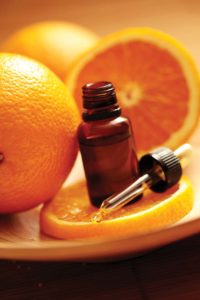
Essential Scents
Like a cartoon character floating toward the freshly baked pie cooling on the windowsill, certain aromas move us all. Hailey’s Michele Davis has had a passion for aromas from an early age; her French mother would often return from the old country with wondrous scents, like lavender from Provence.
“I’ve always resonated with the attractions of scents and what they can do on emotional, physical and spiritual levels,” said Davis.While working for the Natural Niche health store in Ketchum, Davis took a course with Kurt Schnaubelt, an aromatherapy authority.
Davis often carries a small travel kit of essential oils with her. Recently, while getting her hair done, Davis’ stylist was so congested, she could barely breathe. Davis pulled out her magic kit of oils. “I dropped some eucalyptus on a tissue. The stylist breathed in the aroma and said, ‘Oh, my gosh!’ She could breathe again.”
Essential oils, Davis said, can also be combined with a carrier oil, like almond, and massaged into the skin. Another common aromatherapy technique is to inhale a mist released from a diffuser. Some people just place a drop on the tip of the finger and breathe it in. “It’s important for people to get organic, pure or wild crafted types of oils,” she insists. “Some people are sensitive, so just try a little at first. People are not used to smelling a real pure scent anymore—scents have been so manipulated by industry.”
Lavender is still one of her favorite essential oils. She calls it the “type O” of aromatherapy because of its many therapeutic benefits. “It’s been known to work wonderfully on burns and insect bites. It’s a great insect repellent as well—they use it in France to repel scorpions! To soothe headaches, there are remedies with peppermint and lavender combined. It’s wonderful for insomnia and on an emotional level it’s very calming.” (Davis suggests spraying a lavender-water elixir on bed pillows.)
And for pure pleasure, she loves jasmine. “I love the sensation I get on many levels from using essential oils and knowing that not only are they working on a healing level, but they’re giving me a lot of pleasure in the process. If people need scientific proof, that’s there, too.” (She suggests Kurt Schnaubelt’s book, Advanced Aromatherapy, from Healing Arts Press.)
“To me, it’s about taking back your own health. It’s one more way of not giving up to institutionalized and industrialized health care—one of the ways I can take care of myself that is very pleasurable as well as healing. It just makes me feel good.”
Stretching Redefined
Every diligent athlete knows the saying: Don’t forget to stretch. The benefits range from the obvious (increased flexibility), to the surprising (improved circulation). According to the Mayo Clinic, a good stretch can do all of these things, but remembering is just the start. How to stretch is where it gets a bit trickier.
From gym class on, most of us were schooled in a static type of stretching, where a muscle is elongated and the position held for 10 seconds or so. Joggers with legs up on fence posts have etched the common stretch in our minds.
Aaron Mattes is working to change all that. The Florida-based sports trainer and physical therapist is pioneering a new type of stretching, called Active Isolated Stretching (AIS). Locally, sports trainers from the Zenergy Health Club and Spa in Ketchum are adopting the “Mattes Method” of short, two-second stretches into their practices.
Winston Purkiss is the director of Zenergy’s AIS program and is a staunch believer. In early 2007, two strokes left Purkiss’ wife, Kim Walbaum, unable to use her right arm. Doctors advised a permanent brace, but when Mattes saw Walbaum, he suggested stretching.
Walbaum worked with Mattes for 16 hours in just four days—a grueling therapy schedule—and her progress was immediate. “She went from not being able to move her right arm, to picking up a water bottle, taking a drink and putting it back down,” Purkiss said.
Mattes’ AIS methods have helped patients with a variety of neuromuscular disorders, including multiple sclerosis, regain movement and relieve pain.
In 2008, part-time Ketchum resident Tod Hamachek was struck down with a moderate case of Guillain-Barré Syndrome, a rare autoimmune disease that can cause temporary muscle paralysis, extreme pain and even death. Hamachek was bedridden for weeks and had to learn how to walk all over again.
“You don’t remember how you learned when you were 12 or 14 months old,” he said. “And let me tell you, it’s damn tough when you’re not a foot off the ground anymore.”
Hamachek said that the Mattes Method greatly accelerated his rehabilitation.
“It helped immensely in terms of my flexibility and posture and overall strength. It made a huge difference.”
This March, Mattes will hold a workshop for professional trainers at Zenergy. -SVM
Web Extras
Where to Meditate Locally:
Mary Kay Foley, coordinator of St. Luke’s Integrative Therapies Program, said that her hospital’s approach to meditation honors the wide array of contemplative prayer and thought.
“Most religious traditions have some form of contemplative prayer, which like meditation, but in a traditional religious sense,” Foley said. To that end, she has recruited meditation session-leaders from various religious and non-denomoniational backgrounds. Session-leaders have included Redman, Chubb and Skonie, and also Janet Abromeit, John Moreland, Cally Huttar, Susan Fierman, Jeanne Pudoff, Candace Whitt, Myra Lewin, and Bob Henley of the Church of the Big Wood.
Contact Foley at 208-727-8417 for an updated schedule of meditation sessions and teachers.
Further Reading:
The Happiest Man in the World? The Independent talks about Matthieu Ricard, the French academic-turned-Buddhist monk whose positive-thought brain waves are off the charts.
The Science of Meditation: Still skeptical? Scientific American gets technical on the neurochemistry of meditating.
And for you truly ambitious arm-chair scientists out there, check out Richard Davidson‘s research. The Harvard-trained professor of psychology and psychiatry is a leader in the field on neuro-chemical research and its relevance to meditation.
Listen to Matthieu Ricard: Ricard’s in-depth interview with Speaking of Faith, an American Public Radio production.
What your local experts are reading:
Valerie Skonie has been meditating for thirty years. “So I’ve had many teachers,” she says, and her list of favorite texts on the subject is lengthy. She did share a few key texts as the building blocks to her spiritual understanding:
Zen Mind, Beginner’s Mind, by Shunryu Suzuki
Dancing with Life: Buddhist Insights for Finding Meaning and Joy in the Face of Suffering by Phillip Moffitt
Awakening Compassion by Pema Chodron
For a complete list of Valerie’s suggested reading, click here
Ryan Redman is a Valley yoga teacher and meditation practitioner. He incorporates meditation as part of his yoga practice and leads smaller groups in meditation sessions.
Some books Ryan has found crucial to his understanding:
The Attention Revolution by B. Alan Wallace
Ryan says Wallace’s book “lays down a real fundamental practice that then can be used in all forms of meditation, the practice of balancing attention.” Ryan says Wallace’s book is bolstered by scientific insights, balanced with ancient knowledge gleaned from the contemplative traditions.
The Joy of Living: Unlocking the Secret and Science of Happiness by Yongey Mingyur Rinpoche.


